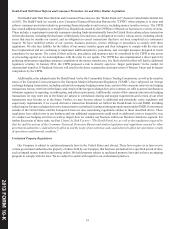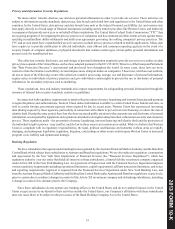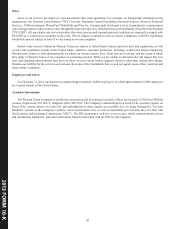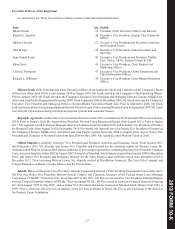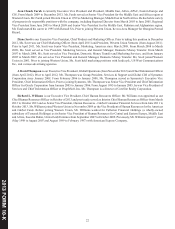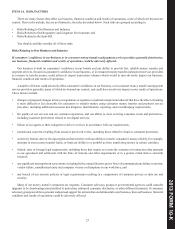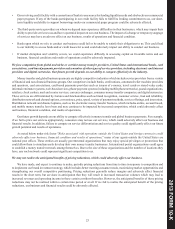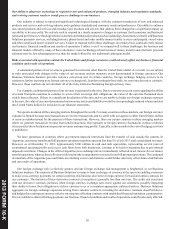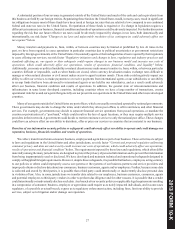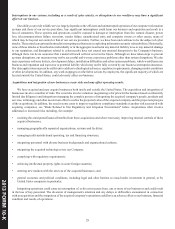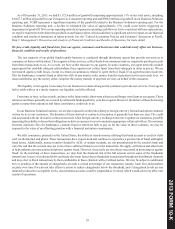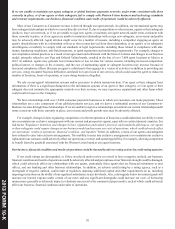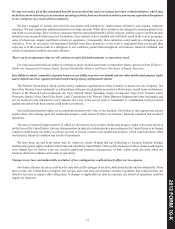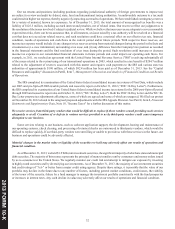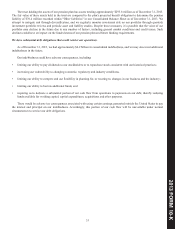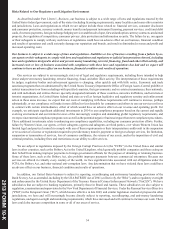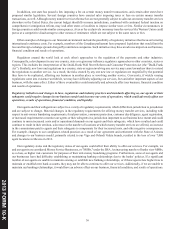Western Union 2013 Annual Report Download - page 136
Download and view the complete annual report
Please find page 136 of the 2013 Western Union annual report below. You can navigate through the pages in the report by either clicking on the pages listed below, or by using the keyword search tool below to find specific information within the annual report.
2013 FORM 10-K
26
Our ability to adopt new technology to respond to new and enhanced products, changing industry and regulatory standards,
and evolving customer needs or trends poses a challenge to our business.
Our industry is subject to rapid and significant technological changes, with the constant introduction of new and enhanced
products and services and evolving industry and regulatory standards and consumer needs and preferences. Our ability to enhance
our current products and services and introduce new products and services that address these changes has a significant impact on
our ability to be successful. We actively seek to respond in a timely manner to changes in customer (both consumer and business)
needs and preferences, technology advances and new and enhanced products such as technology-based money transfer and Business
Solutions payments services, including Internet, phone-based and other mobile money transfer services and prepaid, stored-value
and other card-based money transfer services. Failure to respond well to these challenges on a timely basis could adversely impact
our business, financial condition and results of operations. Further, even if we respond well to these challenges, the business and
financial models offered by many of these alternative, more technology-reliant means of money transfer and electronic payment
solutions may be less advantageous to us than the model offered by our traditional cash/agent model.
Risks associated with operations outside the United States and foreign currencies could adversely affect our business, financial
condition and results of operations.
A substantial portion of our revenue is generated in currencies other than the United States dollar. As a result, we are subject
to risks associated with changes in the value of our revenues and net monetary assets denominated in foreign currencies. Our
Business Solutions business provides currency conversion and, in certain countries, foreign exchange hedging services to its
customers, further exposing us to foreign currency exchange risk. In order to mitigate these risks, we enter into derivative contracts.
However, these contracts do not eliminate all of the risks related to fluctuating foreign currency rates.
For example, a substantial portion of our revenue is generated in the euro. Due to concerns in recent years regarding the ability
of certain European countries to continue to service their sovereign debt obligations, the value of the euro has fluctuated more
widely than in the past. If there is a significant devaluation of the euro and we are unable to hedge our foreign exchange exposure
to the euro, the value of our euro-denominated net monetary assets and liabilities would be correspondingly reduced when translated
into United States dollars for inclusion in our financial statements.
We operate in almost all the emerging markets throughout the world. For many countries in these markets, our foreign currency
exposure is limited because most transactions are receive transactions and we settle with our agents in either United States dollars
or euros as reimbursement for the payment of these transactions. However, there are certain countries in these emerging markets
where we generate transaction revenue from send transactions. Our exposure to foreign currency fluctuations in those countries
is increased as these fluctuations impact our revenues and operating profits. Typically, in these markets the cost of hedging activities
is prohibitive.
We have operations in countries where government-imposed restrictions limit the transfer of cash outside the country. In
Argentina, our money transfer and bill payment operations together represent less than 5% of our 2013 total consolidated revenues.
However, as of December 31, 2013, approximately $100 million in cash and cash equivalents, representing several years of
accumulated operating profits and excess cash flows from both businesses, continue to be held in Argentina due to government
imposed restrictions. Changes in the official Argentine peso exchange rate are immediately reflected in net income for our money
transfer operations, whereas these effects are reflected in other comprehensive income for our bill payment operations. The continued
devaluation of the Argentine peso and limits on returning excess cash balances could further adversely affect future distributions
and our results of operations.
Our foreign exchange risk is relatively greater, and our foreign exchange risk management is heightened, in our Business
Solutions business. The majority of Business Solutions' revenue is from exchanges of currency at the spot rate enabling customers
to make cross-currency payments. In certain countries, this business also writes foreign currency forward and option contracts for
our customers. The duration of these derivative contracts at inception is generally less than one year. The credit risk associated
with our derivative contracts increases when foreign currency exchange rates move against our customers, possibly impacting
their ability to honor their obligations to deliver currency to us or to maintain appropriate collateral with us. Business Solutions
aggregates its foreign exchange exposures arising from customer contracts, including the derivative contracts described above,
and hedges the resulting net currency risks by entering into offsetting contracts with established financial institution counterparties.
If we are unable to obtain offsetting positions, our business, financial condition and results of operations could be adversely affected.




